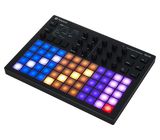Die Idee des Synth ist nicht allzu weit entfernt von Geräten wie dem Sh4d oder dem Syntakt: Ein multitimbrales instrument mit verschiedenen Sound-Engines. Die Bedienung hat man von Elektron abgeschaut, ist aber weit noch weit von der eleganten und polierten Elektron UX entfernt, dazu gibt es doch zu viele Inkonsistenzen und ein Hardware und Grafik-Design, das an vielen Stellen zu einfach gedacht und zu unübersichtlich ist. Im Moment sieht man nicht mal, zu welchem Sound das Makro gehört, das man gerade bearbeitet, und es ist recht leicht, aus versehen einen Sound oder eine Scene zu überschreiben, die man behalten wollte.
Auch die verwendeten Encoder sind sind nicht so gut wie die von Elektron, sie sind schwergängig und reagieren etwas träge, was gerade bei den Macros das flüssige Schrauben am Sound verhindert. Und über MIDI sind gerade die Macros nicht zugänglich.
Auch andere Aspekte der Anbindung über MIDI lassen (noch?) zu wünschen übrig, man innerhalb eines Parts per Program Change nur maximal zwischen 8 Sounds desselben Engines umschalten, und eine Anwahl der Scenes über Program Changes ist nicht vorgesehen. Da die Scenes auch keine festen Speicherplätze haben, ist das auch nicht so einfach umzusetzen.
Die Sound-Engines klingen durch die Bank gut, die Qualität des Klangs ist durchaus dem Sh-4d ebenbürtig. Leider ist im Vergleich zu diesem sowohl die Ausstattung an Effekten (beim Synth sind es nur 3, beim Sh4d dagegen 7, plus EQ pro Track, plus Master Compressor) als auch die Polyphonie stark begrenzt, besonders GRAIN und PMD (physical modelling) bringen das Gerät schnell an seine Grenzen, da sinkt die Polyphonie des Gerätes schnell von theoretisch 8 auf praktisch 3.
Das ist schade, denn gerade diese beiden Engines sind absolute Highlights.
Unter GRAIN darf man sich auch keine ausgefeilte Granularsynthese wie z.B. im Tasty Chips GR-1 vorstellen, und man bekommt auch keine 1000 Grains gleichzeitig, sonder nur 128, aber man bekommt durch die Bank interessante, lebendige und gut artikulierbare Sounds, die auch 4-stimmig paraphonisch spielbar sind. Was die Reduktion der Polyphonie wieder etwas verschmerzen lässt.
Auch die anderen Engines liefern durchweg gute Sounds, mir persönlich gefällt vor allem PHZ (Phase Distortion), damit hatte ich bis jetzt nie etwas zu tun, und da kommen interessante und für mich neue Sounds zustande. Schade finde ich die feste Verkettung von Filtern zu Engine, das hat nämlich zur Folge, dass der Resonator nur für PMD verfügbar ist. Mich würde der auch bei anderen Engines interessieren.
Die konfigurierbare und sowohl velocity- als auch aftertouch-sensitive Tastenmatrix fand ich anfangs etwas seltsam, aber nachdem ich kapiert hatte, wie man das in Zusammenhang mit Sequenzern und Arps bedient, finde ich das richtig gelungen.
Ich denke schon, dass das Gerät einen langfristigen Platz in meinem Setup finden wird, wünsche mir aber, dass es da noch ein paar Performance-Optimierungen gibt, und Polyend die UX nochmal grundlegend überarbeitet.
Es hilft, wenn man das Gerät vom Konzept her nicht als primär polyhponen Synthesizer betrachtet, sondern eher wie einen Elektron Analog Four, also einen multitimbralen monophonen Synthesizer, den man nur dann polyphon spielen kann, wenn man die Multitimbralität reduziert.


